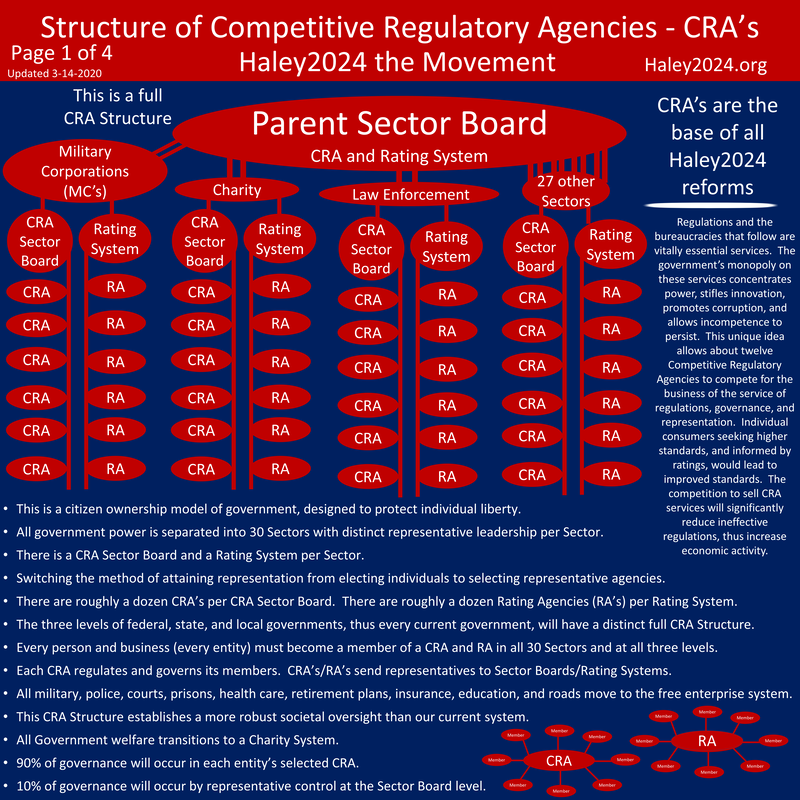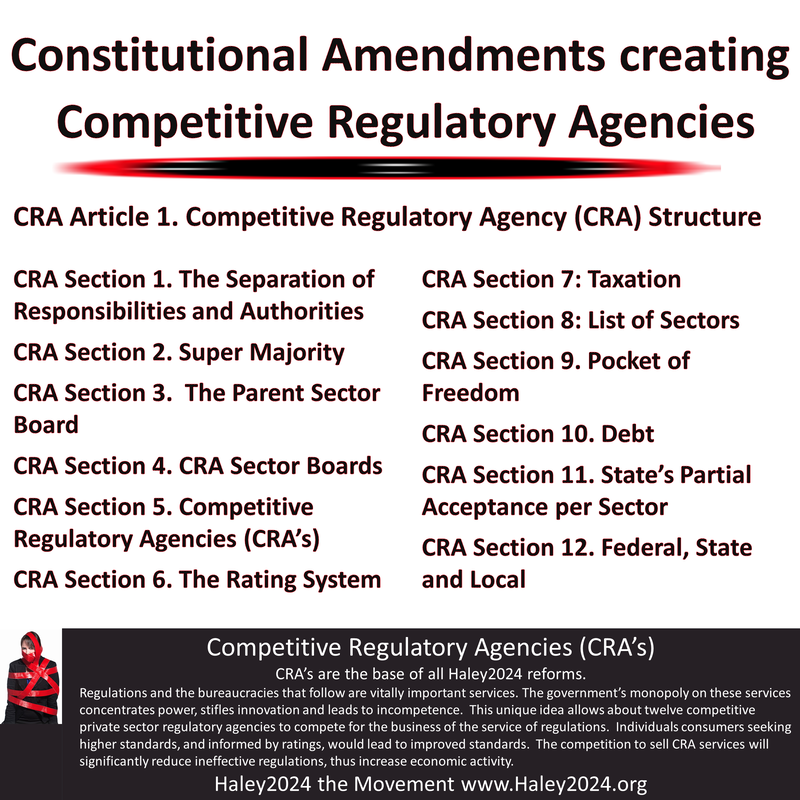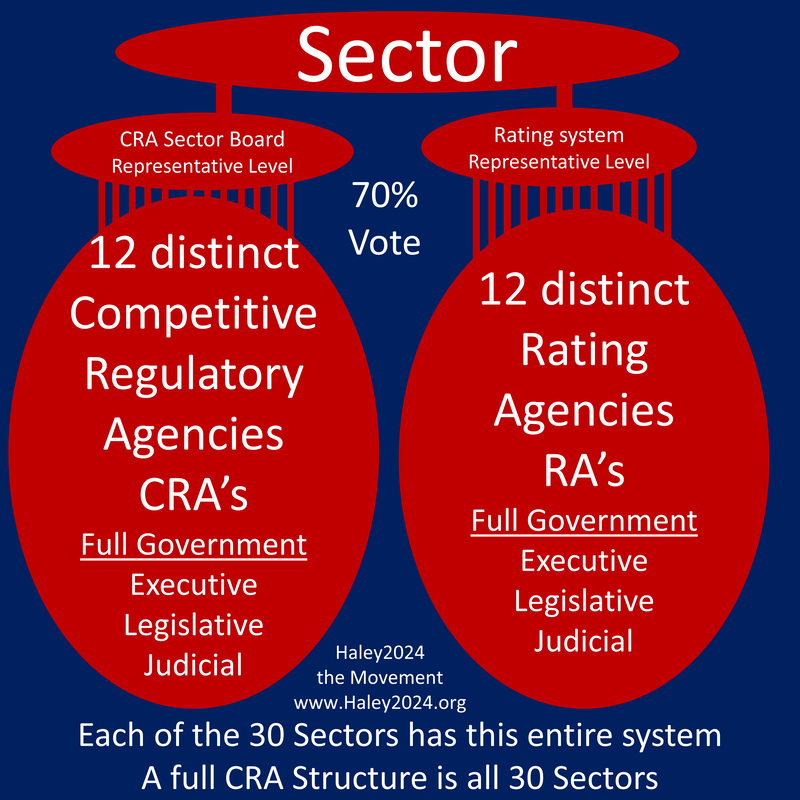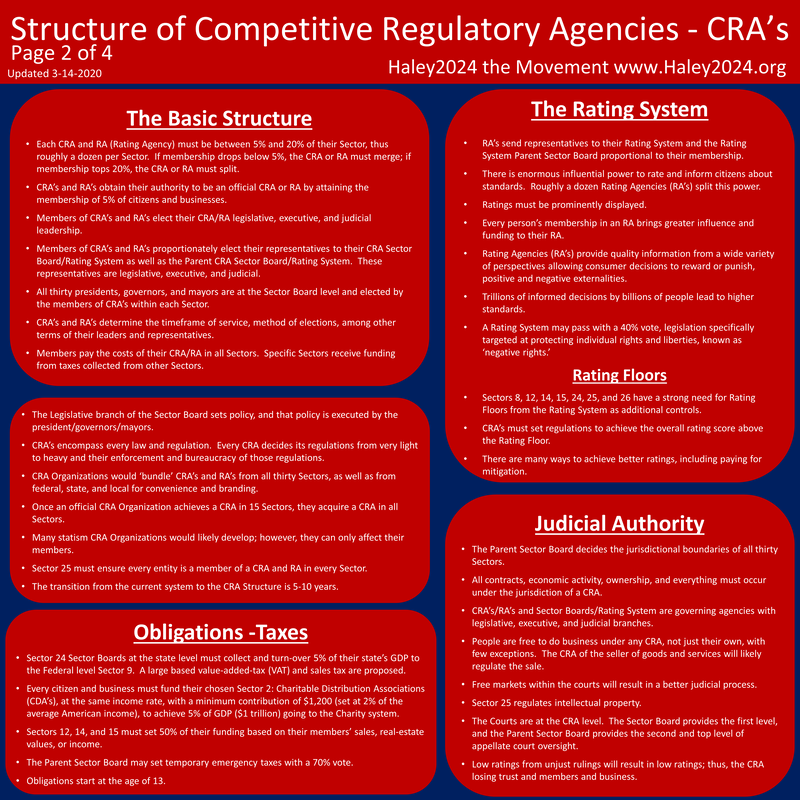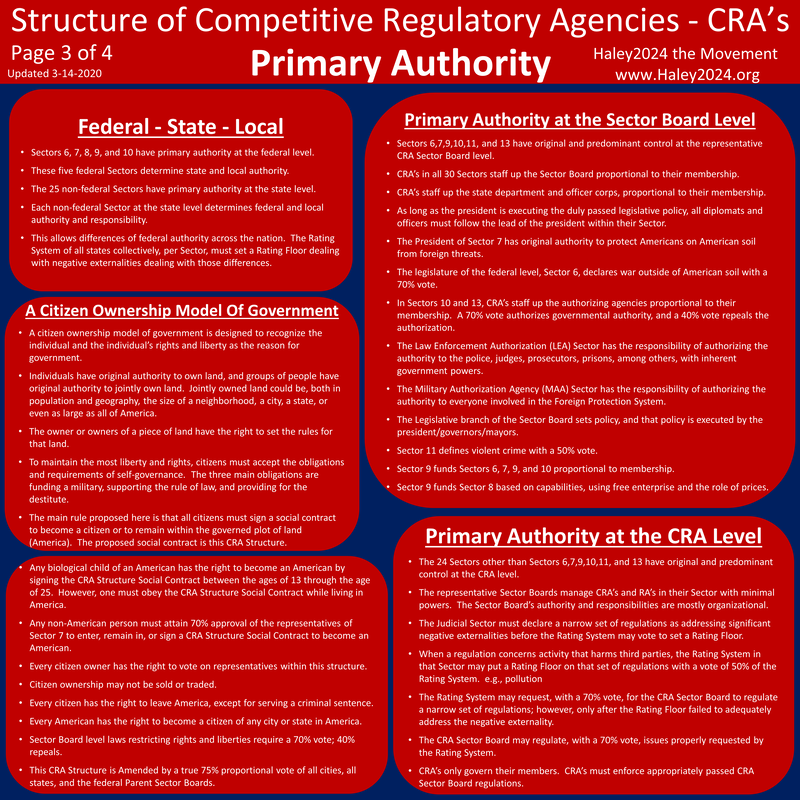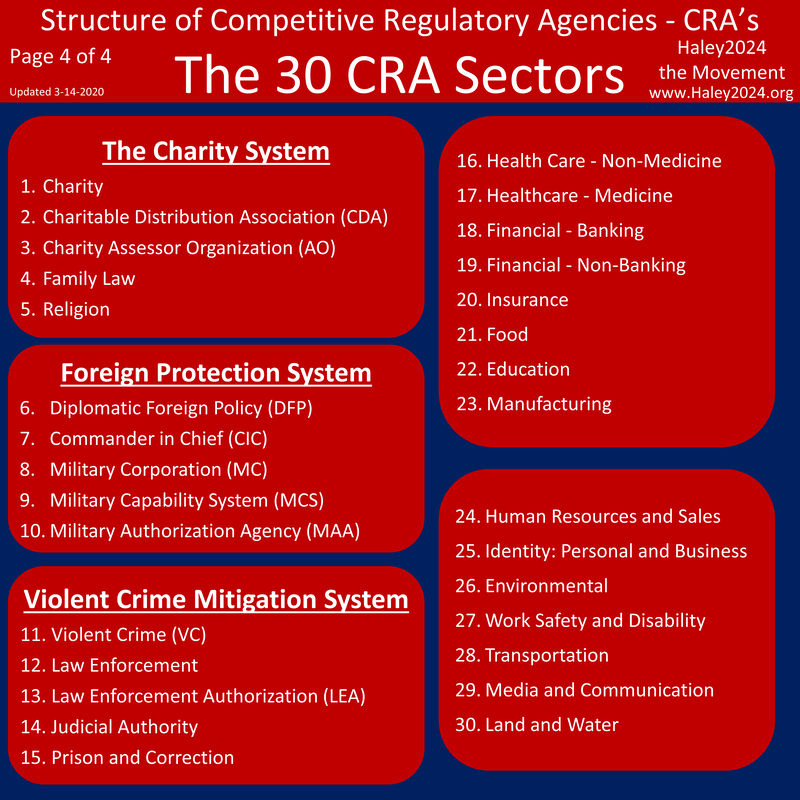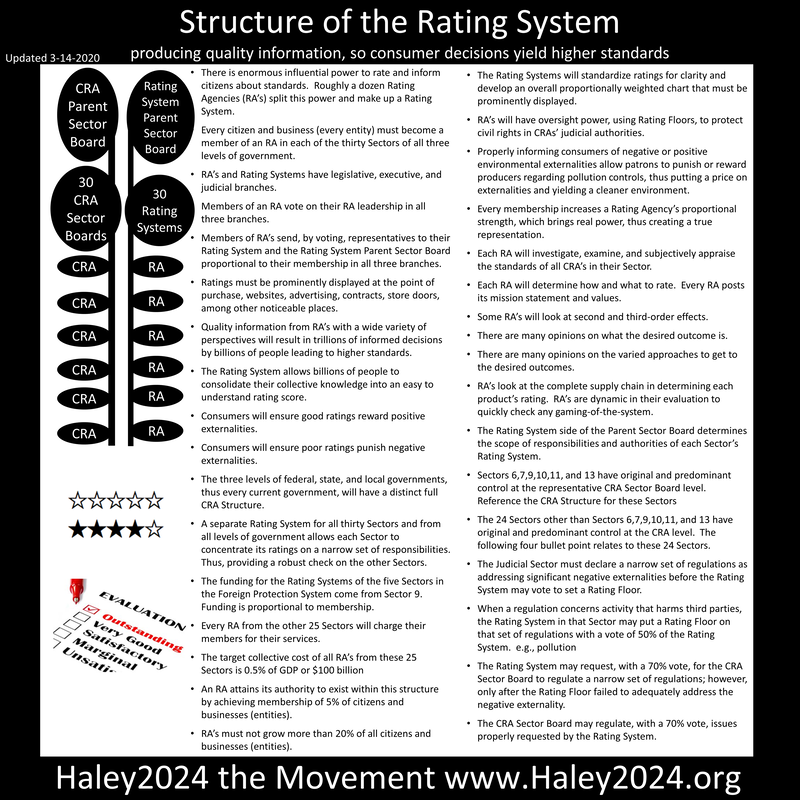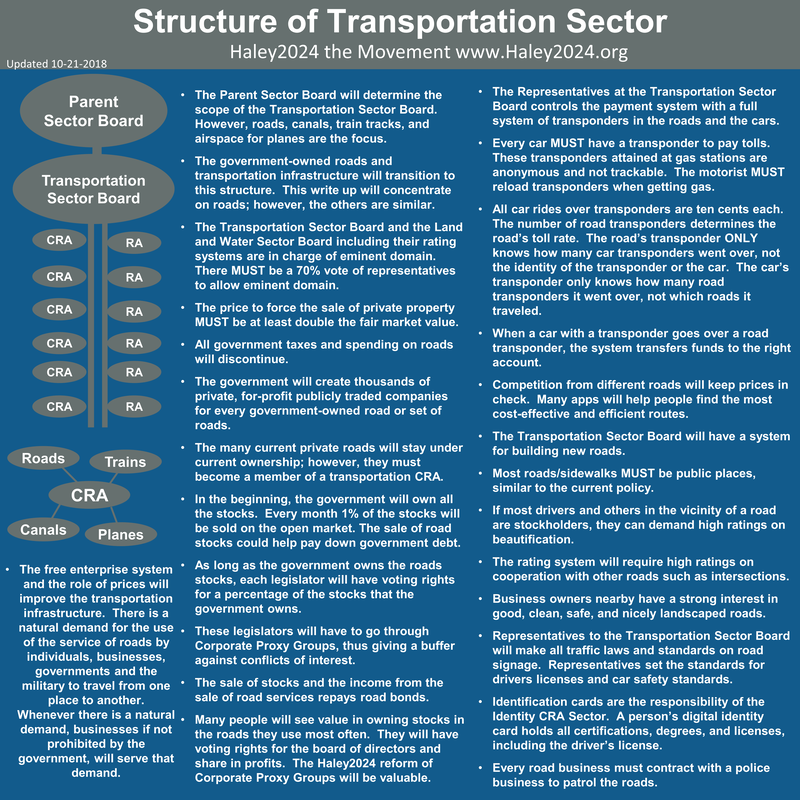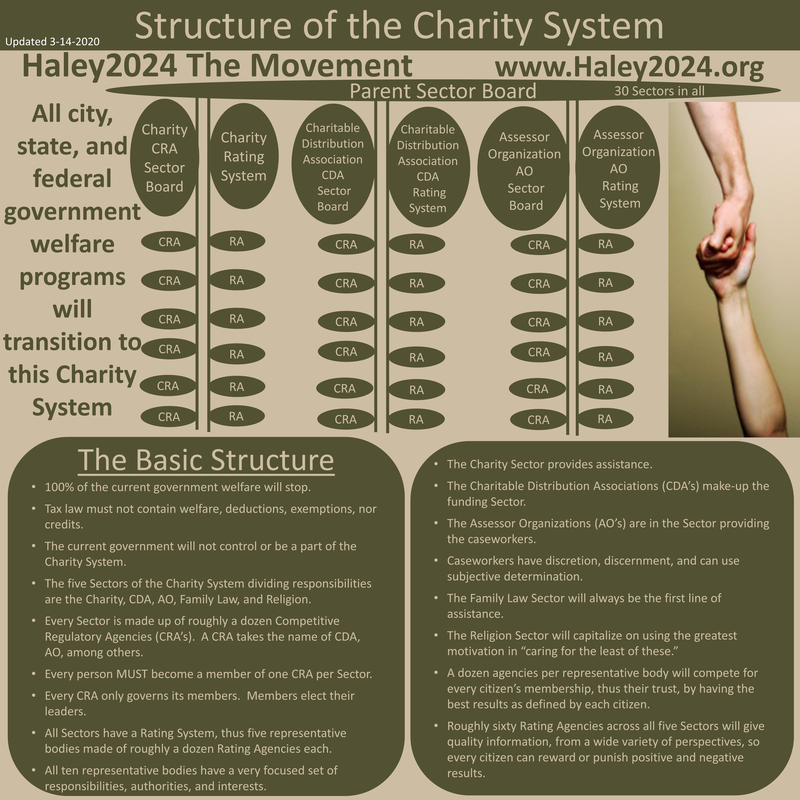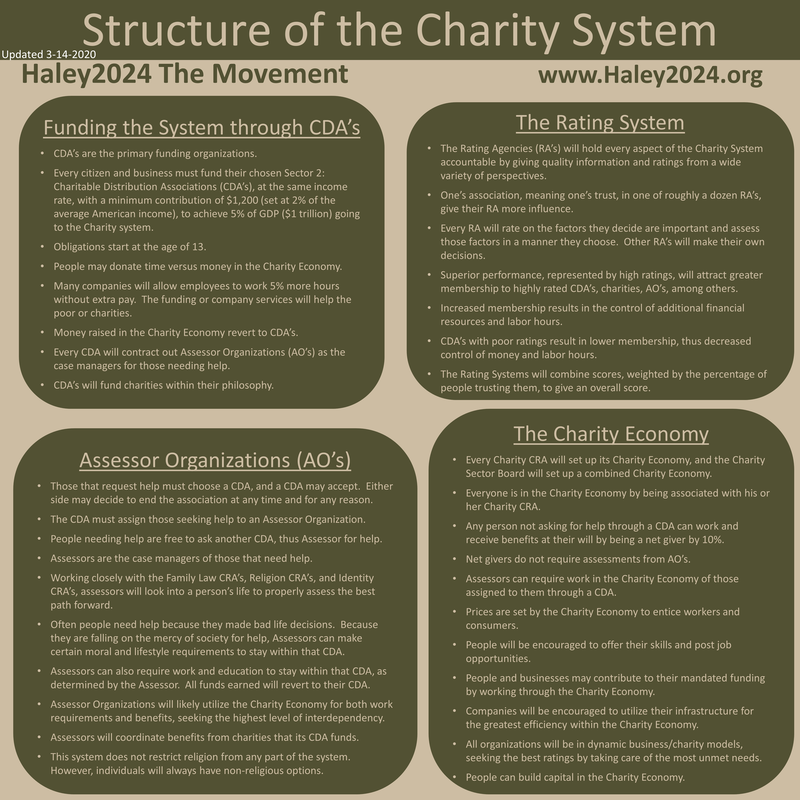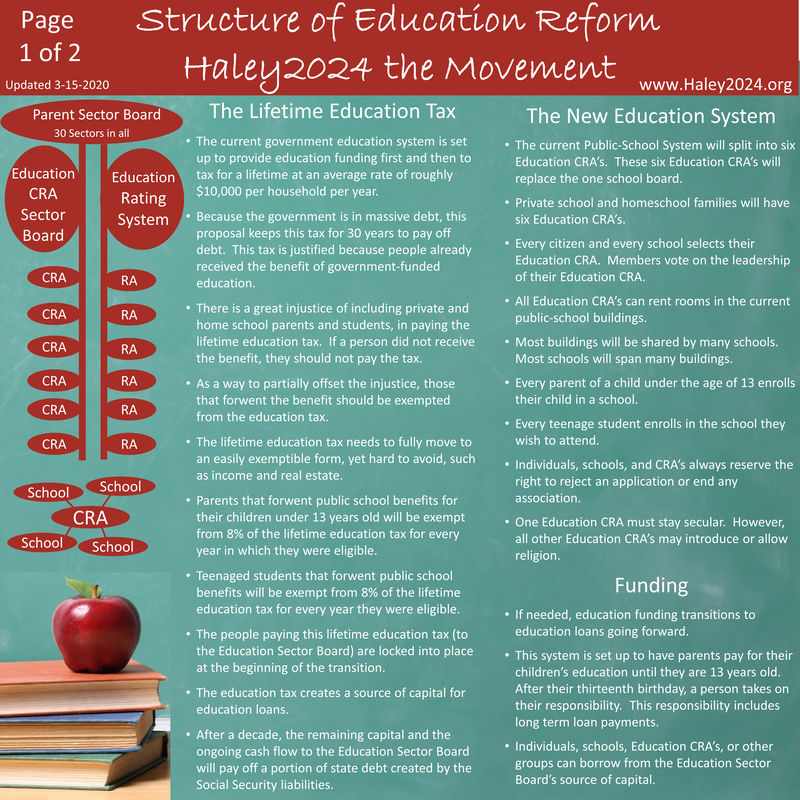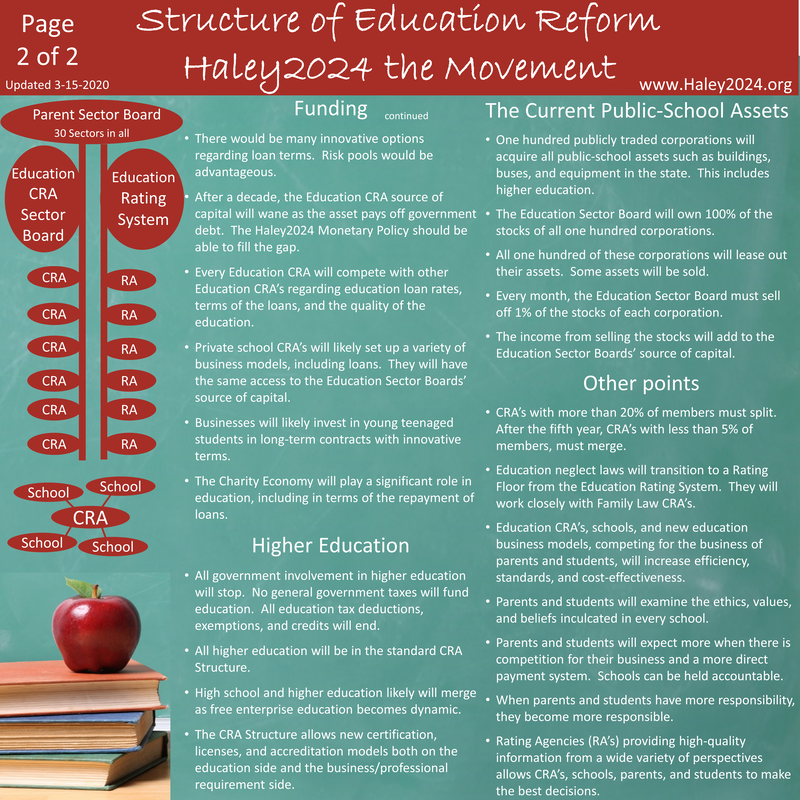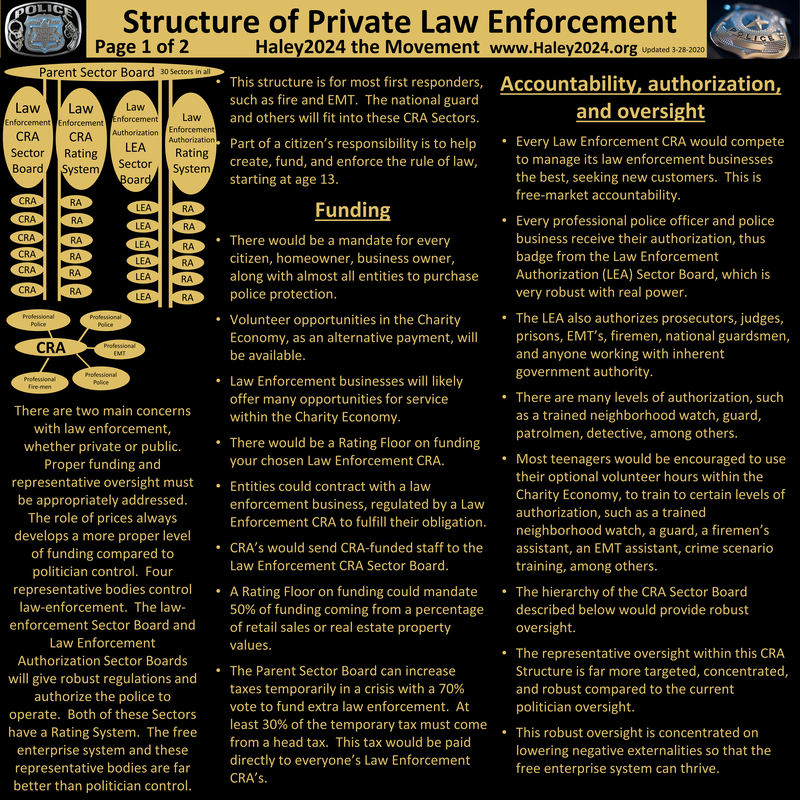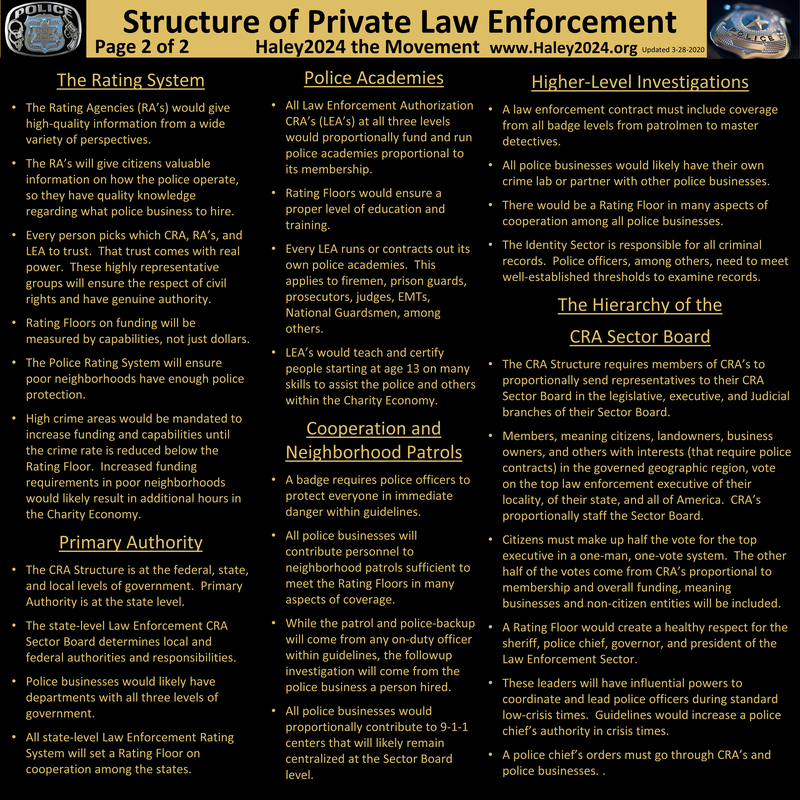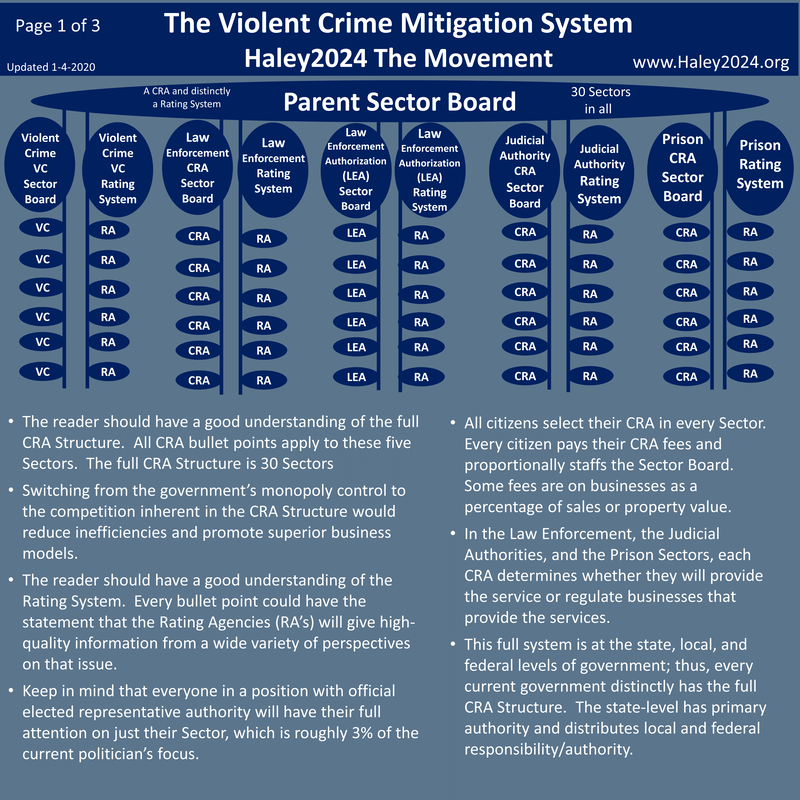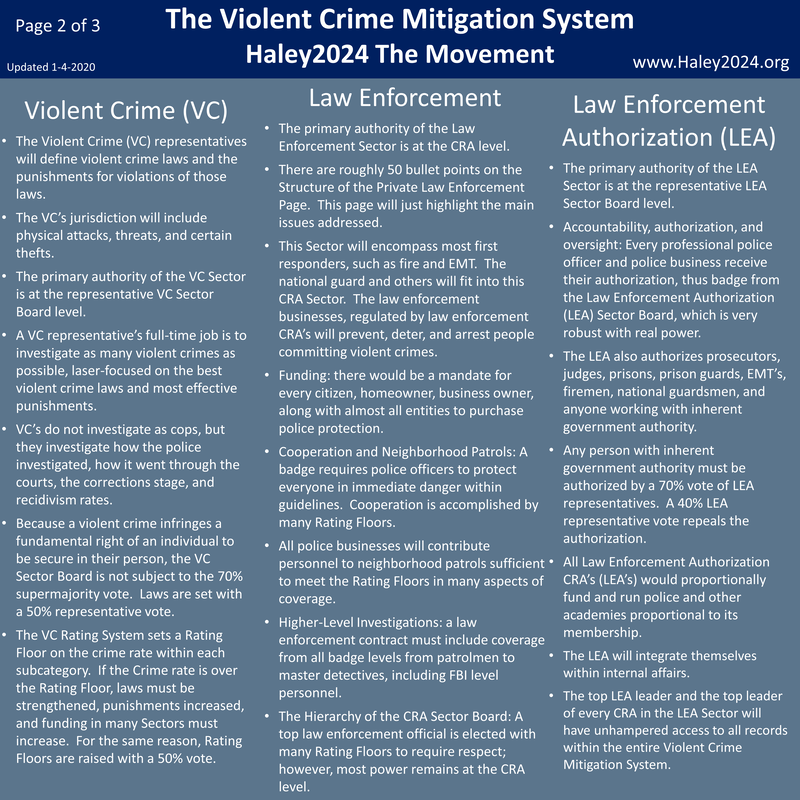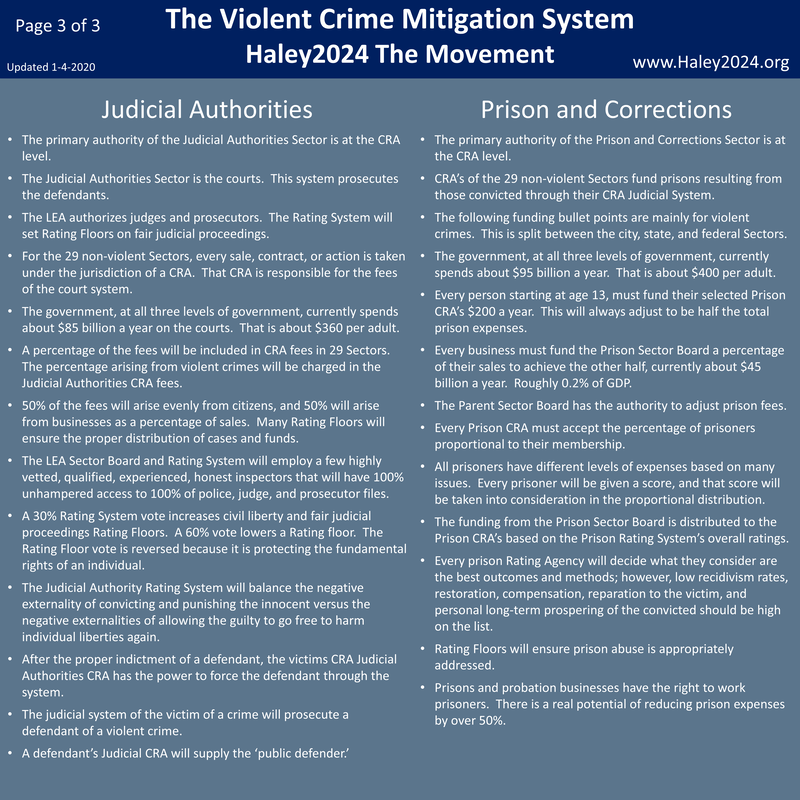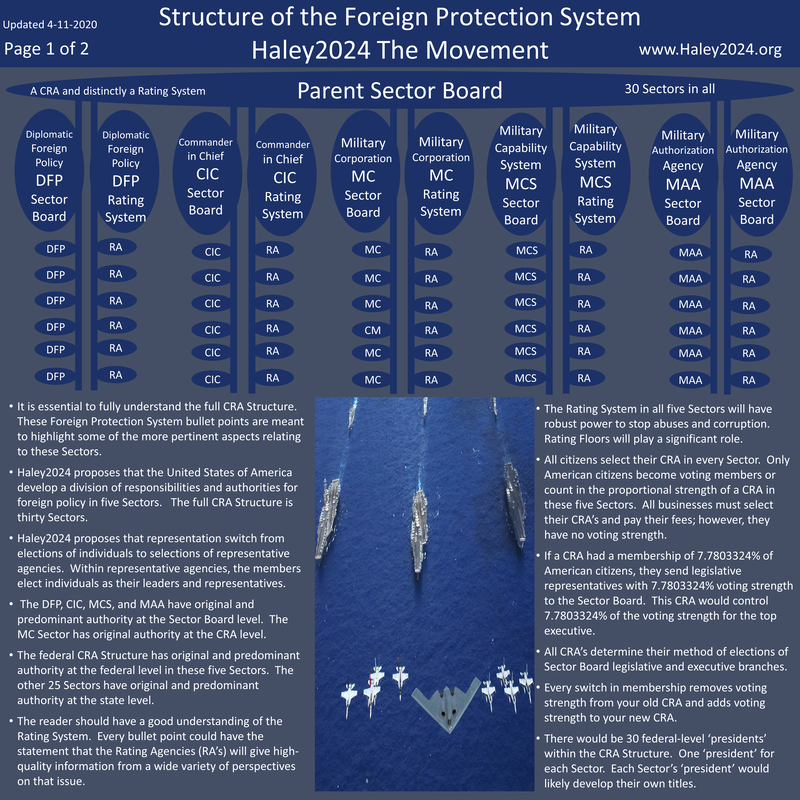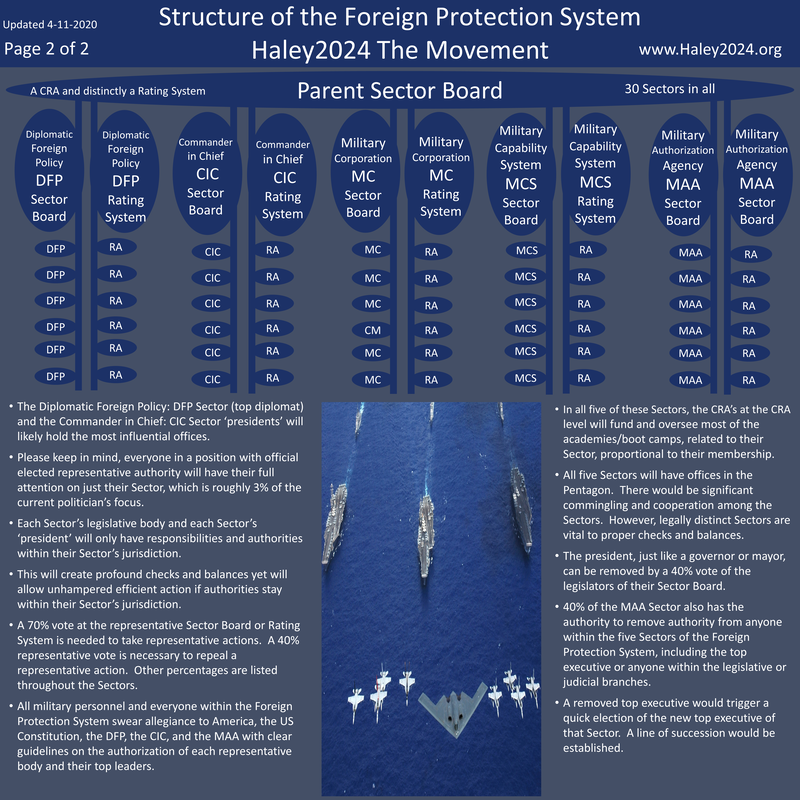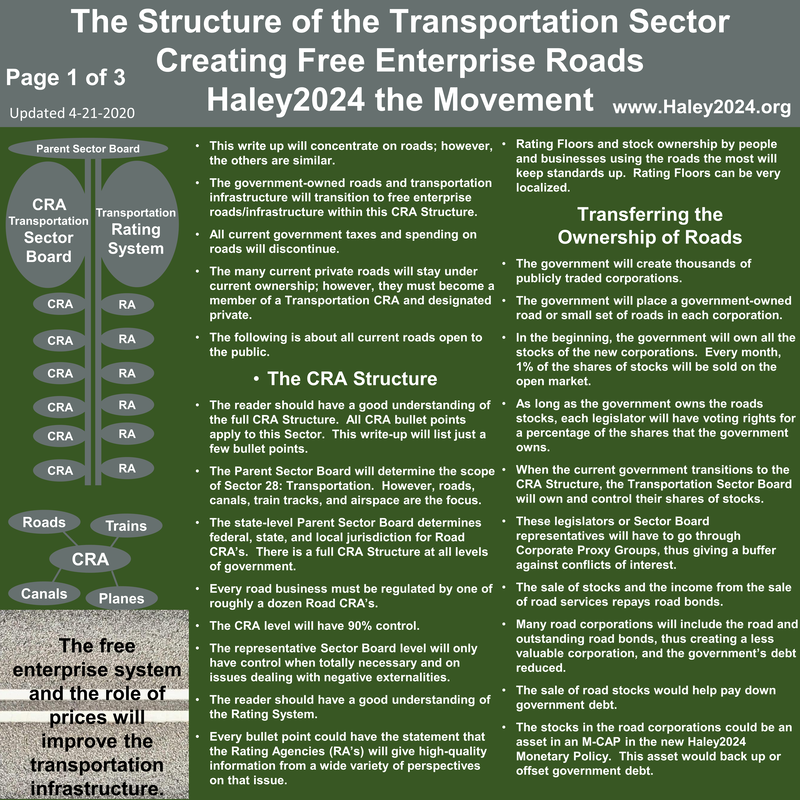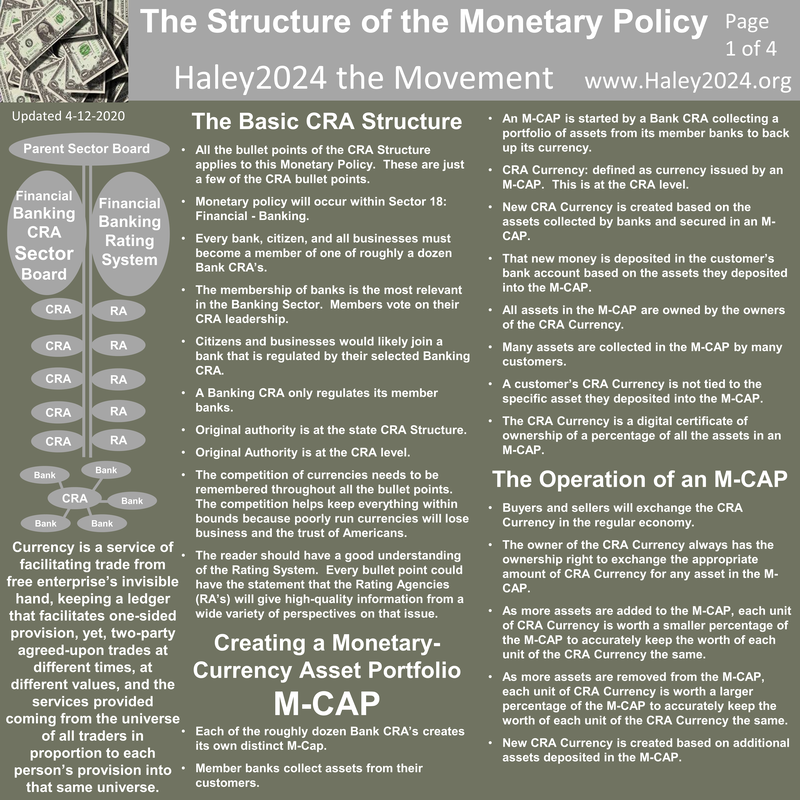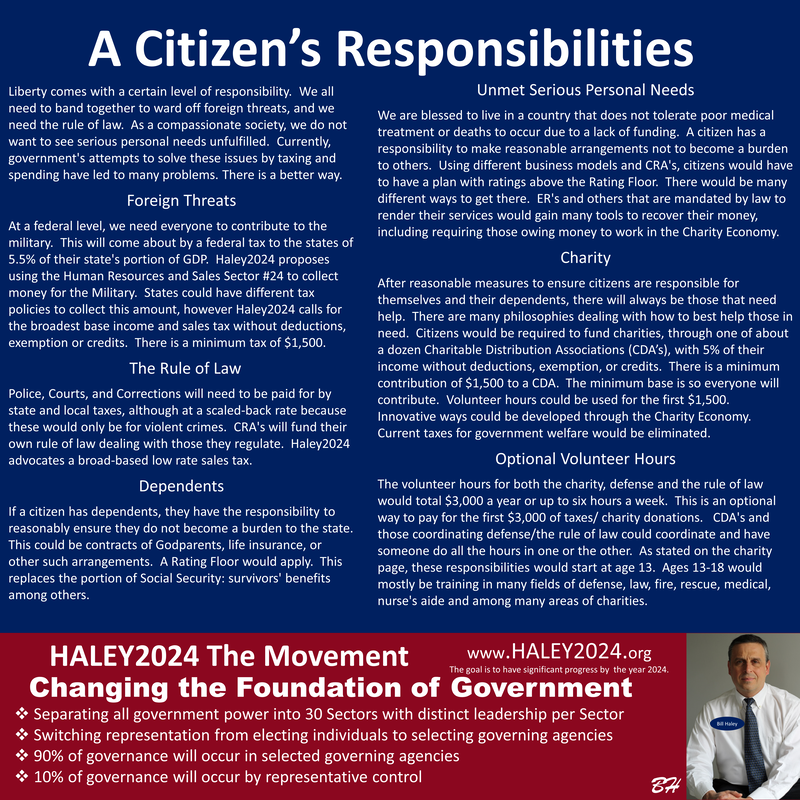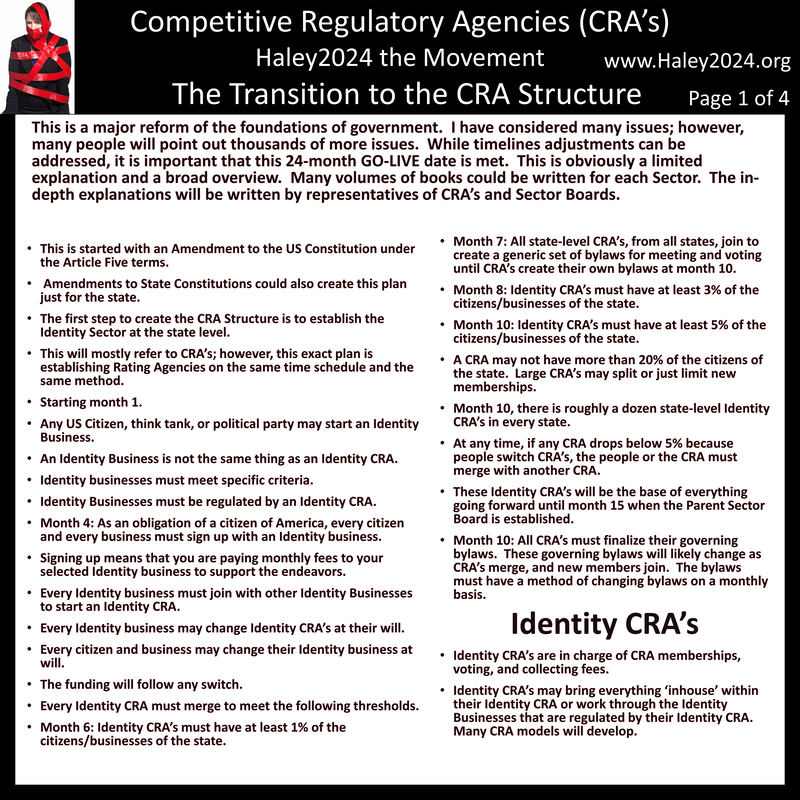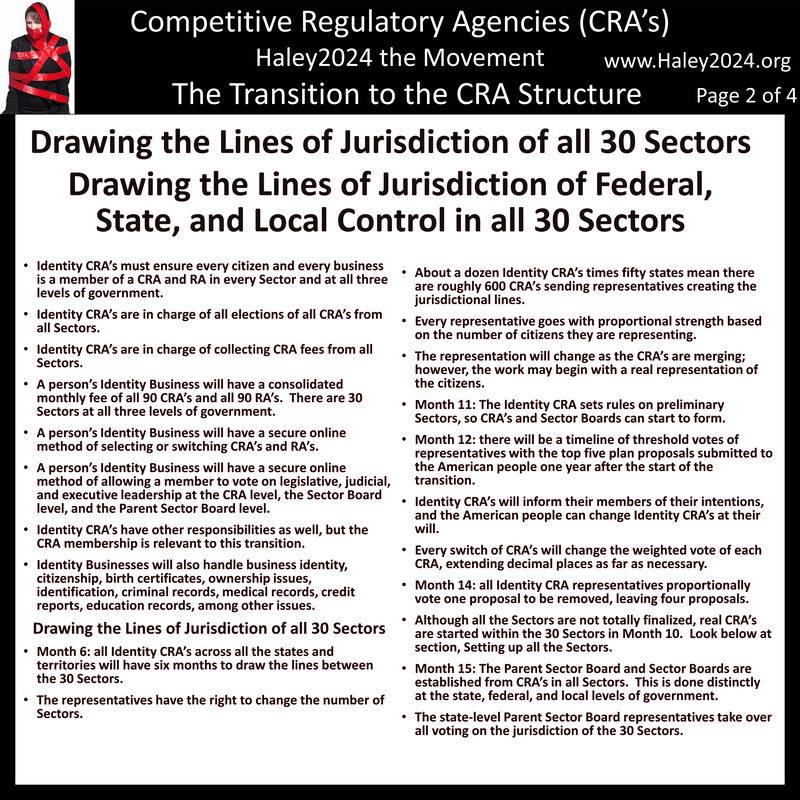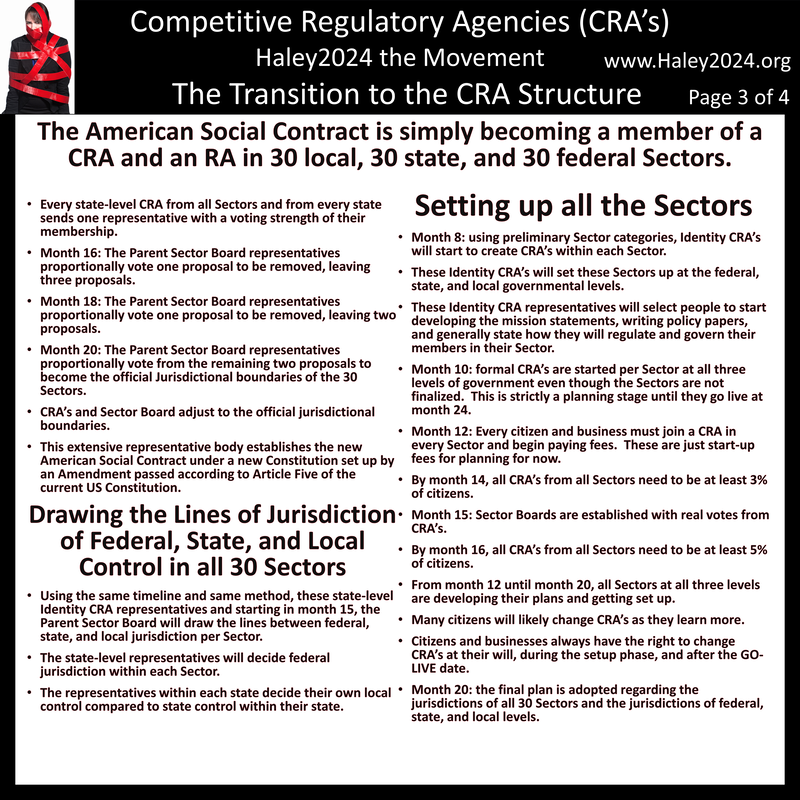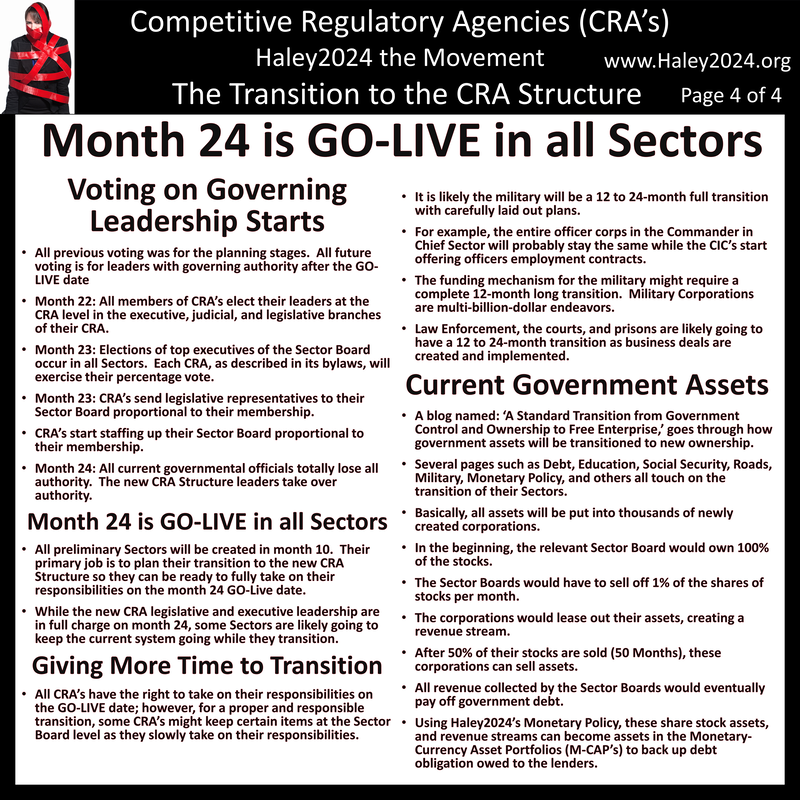| This is a major reform of the foundations of government. I have considered many issues; however, many people will point out thousands of more issues. While timelines adjustments can be addressed, it is important that this 24 month GO-LIVE date is met. This is obviously a limited explanation and a broad overview. Many volumes of books could be written for each Sector. The in-depth explanations will be written by representatives of CRA’s and Sector Boards. |
| This is started with an Amendment to the US Constitution under the Article Five terms. Amendments to state Constitutions could also create this plan just for the state. The first step to create the CRA Structure is to establish the Identity Sector at the state level. This will mostly refer to CRA’s; however, this exact plan is establishing Rating Agencies on the same time schedule and the same method. Starting month 1. |
| Any US Citizen, think tank, or political party may start an Identity Business. An Identity Business is not the same thing as an Identity CRA. Identity businesses must meet specific criteria. Identity Businesses must be regulated by an Identity CRA. Month 4: As an obligation of a citizen of America, every citizen and every business must sign up with an Identity business. |
| Signing up means that you are paying monthly fees to your selected Identity business to support the endeavors. Every Identity business must join with other Identity Businesses to start an Identity CRA. Every Identity business may change Identity CRA’s at their will. Every citizen and business may change their Identity business at will. The funding will follow any switch. |
| Every Identity CRA must merge to meet the following thresholds. Month 6: Identity CRA’s must have at least 1% of the citizens/businesses of the state. Month 7: All state-level CRA’s, from all states, join to create a generic set of bylaws for meeting and voting until CRA’s create their own bylaws at month 10. Month 8: Identity CRA’s must have at least 3% of the citizens/businesses of the state. Month 10: Identity CRA’s must have at least 5% of the citizens/businesses of the state. |
| A CRA may not have more than 20% of the citizens of the state. Large CRA’s may split or just limit new memberships. Month 10, there is roughly a dozen state-level Identity CRA’s in every state. At any time, if any CRA drops below 5% because people switch CRA’s, the people or the CRA must merge with another CRA. These Identity CRA’s will be the base of everything going forward until month 15 when the Parent Sector Board is established. Month 10: All CRA’s must finalize their governing bylaws. These governing bylaws will likely change as CRA’s merge and new members join. The bylaws must have a method of changing bylaws on a monthly basis. |
Identity CRA’s
| Identity CRA’s are in charge of CRA memberships, voting, and collecting fees. Identity CRA’s may bring everything ‘inhouse’ within their Identity CRA or work through the Identity Businesses that are regulated by their Identity CRA. Many CRA models will develop. Identity CRA’s must ensure every citizen and every business is a member of a CRA and RA in every Sector and at all three levels of government. Identity CRA’s are in charge of all elections of all CRA’s from all Sectors. Identity CRA’s are in charge of collecting CRA fees from all Sectors. |
| A person’s Identity Business will have a consolidated monthly fee of all 90 CRA’s and all 90 RA’s. There are 30 Sectors at all three levels of government. A person’s Identity Business will have a secure online method of selecting or switching CRA’s and RA’s. A person’s Identity Business will have a secure online method of allowing a member to vote on legislative, judicial, and executive leadership at the CRA level, the Sector Board level, and the Parent Sector Board level. Identity CRA’s have other responsibilities as well, but the CRA membership is relevant to this transition. Identity Businesses will also handle business identity, citizenship, birth certificates, ownership issues, identification, criminal records, medical records, credit reports, education records, among other issues. |
Drawing the Lines of Jurisdiction of all 30 Sectors
| Month 6: all Identity CRA’s across all the states and territories will have six months to draw the lines between the 30 Sectors. The representatives have the right to change the number of Sectors. About a dozen Identity CRA’s times fifty states mean there are roughly 600 CRA’s sending representatives creating the jurisdictional lines. Every representative goes with proportional strength based on the number of citizens they are representing. The representation will change as the CRA’s are merging; however, the work may begin with a real representation of the citizens. |
| Month 11: The Identity CRA sets rules on preliminary Sectors, so CRA’s and Sector Boards can start to form. Month 12: there will be a timeline of threshold votes of representatives with the top five plan proposals submitted to the American people one year after the start of the transition. Identity CRA’s will inform their members of their intentions, and the American people can change Identity CRA’s at their will. Every switch of CRA’s will change the weighted vote of each CRA, extending decimal places as far as necessary. Month 14: all Identity CRA representatives proportionally vote one proposal to be removed, leaving four proposals. |
| Although all the Sectors are not totally finalized, real CRA’s are started within the 30 Sectors in Month 10. Look below at section, Setting up all the Sectors. Month 15: The Parent Sector Board and Sector Boards are established from CRA’s in all Sectors. This is done distinctly at the state, federal, and local levels of government. The state-level Parent Sector Board representatives take over all voting on the jurisdiction of the 30 Sectors. Every state-level CRA from all Sectors and from every state sends one representative with a voting strength of their membership. Month 16: The Parent Sector Board representatives proportionally vote one proposal to be removed, leaving three proposals. |
| Month 18: The Parent Sector Board representatives proportionally vote one proposal to be removed, leaving two proposals. Month 20: The Parent Sector Board representatives proportionally vote from the remaining two proposals to become the official Jurisdictional boundaries of the 30 Sectors. CRA’s and Sector Board adjust to the official jurisdictional boundaries. This extensive representative body establishes the new American Social Contract under a new Constitution set up by an Amendment passed according to Article Five of the current US Constitution. |
Drawing the Lines of Jurisdiction of Federal, State, and Local Control in all 30 Sectors
| Using the same timeline and same method, these state-level Identity CRA representatives and starting in month 15, the Parent Sector Board will draw the lines between federal, state, and local jurisdiction per Sector. The state level representatives will decide federal jurisdiction within each Sector. The representatives within each state decide their own local control compared to state control within their state. |
Setting up all the Sectors
| Month 8: using preliminary Sector categories, Identity CRA’s will start to create CRA’s within each Sector. These Identity CRA’s will set these Sectors up at the federal, state, and local governmental levels. These Identity CRA representatives will select people to start developing the mission statements, writing policy papers, and generally state how they will regulate and govern their members in their Sector. Month 10: formal CRA’s are started per Sector at all three levels of government even though the Sectors are not finalized. This is strictly a planning stage until they go live at month 24. |
| Month 12: Every citizen and business must join a CRA in every Sector and begin paying fees. These are just start-up fees for planning for now. By month 14, all CRA’s from all Sectors need to be at least 3% of citizens. Month 15: Sector Boards are established with real votes from CRA’s. By month 16, all CRA’s from all Sectors need to be at least 5% of citizens. |
| From month 12 until month 20, all Sectors at all three levels are developing their plans and getting set up. Many citizens will likely change CRA’s as they learn more. Citizens and businesses always have the right to change CRA’s at their will, during the setup phase and after the GO-LIVE date. Month 20: the final plan is adopted regarding the jurisdictions of all 30 Sectors and the jurisdictions of federal, state, and local levels. |
Voting on Governing Leadership Starts
| All previous voting was for the planning stages. All future voting is for leaders with governing authority after the GO-LIVE date Month 22: All members of CRA’s elect their leaders at the CRA level in the executive, judicial, and legislative branches of their CRA. Month 23: Elections of top executives of the Sector Board occur in all Sectors. Each CRA, as described in its bylaws, will exercise their percentage vote. |
| Month 23: CRA’s send legislative representatives to their Sector Board proportional to their membership. CRA’s start staffing up their Sector Board proportional to their membership. Month 24: All current governmental officials totally lose all authority. The new CRA Structure leaders take over authority. |
Month 24 is GO-LIVE in all Sectors.
| All preliminary Sectors will be created in month 10. Their primary job is to plan their transition to the new CRA Structure so they can be ready to fully take on their responsibilities on the month 24 GO-Live date. While the new CRA legislative and executive leadership are in full charge on month 24, some Sectors are likely going to keep the current system going while they transition. |
Giving More Time to Transition
| All CRA’s have the right to take on their responsibilities on the GO-LIVE date; however, for a proper and responsible transition, some CRA’s might keep certain items at the Sector Board level as they slowly take on their responsibilities. It is likely the military will be a 12 to 24-month full transition with carefully laid out plans. For example, the entire officer corps in the Commander in Chief Sector will probably stay the same while the CIC’s start offering officers employment contracts. The funding mechanism for the military might require a complete 12-month long transition. Military Corporations are multi-billion dollar endeavors. Law Enforcement, the courts, and prisons are likely going to have a 12 to 24-month transition as business deals are created and implemented. |
Current Government Assets
| A blog named: ‘A Standard Transition from Government Control and Ownership to Free Enterprise,’ goes through how government assets will be transitioned to new ownership. Several pages such as Debt, Education, Social Security, Roads, Military, Monetary Policy, and others all touch on the transition of their Sectors. Basically, all assets will be put into thousands of newly created corporations. In the beginning, the relevant Sector Board would own 100% of the stocks. |
| The Sector Boards would have to sell off 1% of the shares of stocks per month. The corporations would lease out their assets, creating a revenue stream. After 50% of their stocks are sold (50 Months), these corporations can sell assets. All revenue collected by the Sector Boards would eventually pay off government debt. Using Haley2024’s Monetary Policy, these share stock assets, and revenue streams can become assets in the Monetary-Currency Asset Portfolios (M-CAP’s) to back up debt obligation owed to the lenders. |
